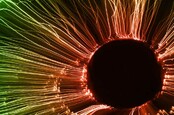This article is more than 1 year old
US boffins tangle with quantum entanglement in spooky rack-mounted networking hardware
Supported by quantum storage that works at room temperature
American researchers have managed to successfully transfer entangled photons over a fibre network stretching approximately 11 miles, marking the longest-distance quantum entanglement experiment to take place in the US.
This is not the largest quantum network ever – that honour belongs to a project in China – but what sets this latest effort apart is the development of portable quantum entanglement sources that fit into a standard server rack and are connected to traditional fibre distribution panels. Now, the same team is working on quantum repeaters that could help create much larger networks.
The project is a collaboration between Brookhaven National Laboratory, Stony Brook University and the Energy Sciences Network, run by the US Department of Energy.

Europe, Japan: D-Wave would really like you to play with its – count 'em – '2,000-qubit' quantum Leap cloud service
READ MOREMaintaining functional qubits in a single quantum computer is a difficult task, requiring a completely isolated physical environment. Quantum networking takes the complexity one step further by throwing quantum entanglement into the mix.
This phenomenon, originally explored by Albert Einstein and Erwin Schrödinger, states that two or more particles can be made to exhibit certain physical properties, and the change to one particle will immediately change the other, even if they are miles apart. Einstein humorously referred to this as "spooky action at a distance".
In the future, quantum networking technology could be used to send information encoded in qubits – basic units of quantum information that can convey one, zero or both at the same time – down the wire to create clusters of quantum computers, with considerably increased compute capacity.
Quantum networking is also essential for quantum key distribution – which enables unhackable encrypted communications, with the encryption key rendered useless if it was observed by anyone but the intended recipient.
In their experiment, researchers built a quantum network testbed stretching across the Brookhaven Lab campus, using Energy Sciences Network fibre and portable entanglement sources.
The team noted that its entanglement machines are compatible with "quantum memories" – an existing tech for storing quantum information in atom-filled glass cells. These cells normally must be kept at absolute zero (-273.15°C or -460°F) – but the team working on the Brookhaven testbed has figured out a way to make them a lot less finicky, and thus much more portable.
"Our quantum memories have the advantage of operating at room temperature rather than requiring subfreezing cold. This makes it natural to expand the test to principles of quantum repeaters, which are the technological key to achieving quantum communication over hundreds of kilometres," said Eden Figueroa, Stony Brook University professor and leader of its Quantum Information Technology group.
It's important to note that, despite being called "repeaters", these devices are very different from traditional network signal amplifiers, because qubits, by definition, cannot be copied.
To test the repeater technology, the team is constructing the necessary optical connections to link Brookhaven Lab's quantum network to ones that already exist at Stony Brook and Yale universities.
With quantum computers, storage devices and networking, we are seeing the beginnings of a specialised hardware ecosystem – but it could take around 10 years before this technology leaves the lab and becomes suitable for practical applications.
"Realizing the quantum network with entangled photon sources mounted in server racks, portable quantum memories, and operable repeaters will mark the first real quantum communication network in the world that truly connects quantum computing processors and memories using photonic quantum entanglement," Figueroa claimed. ®
